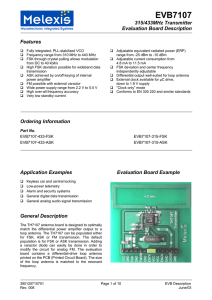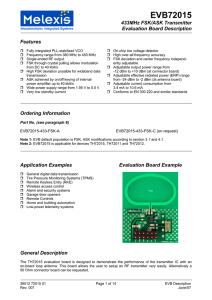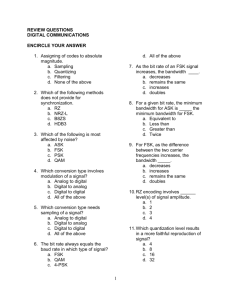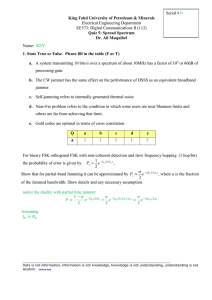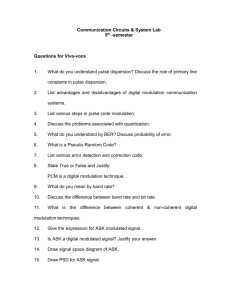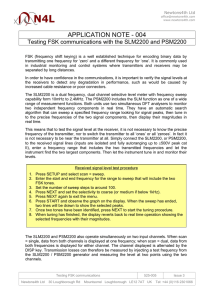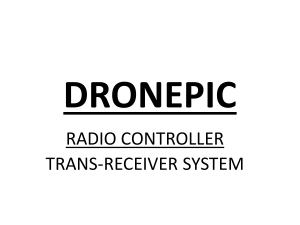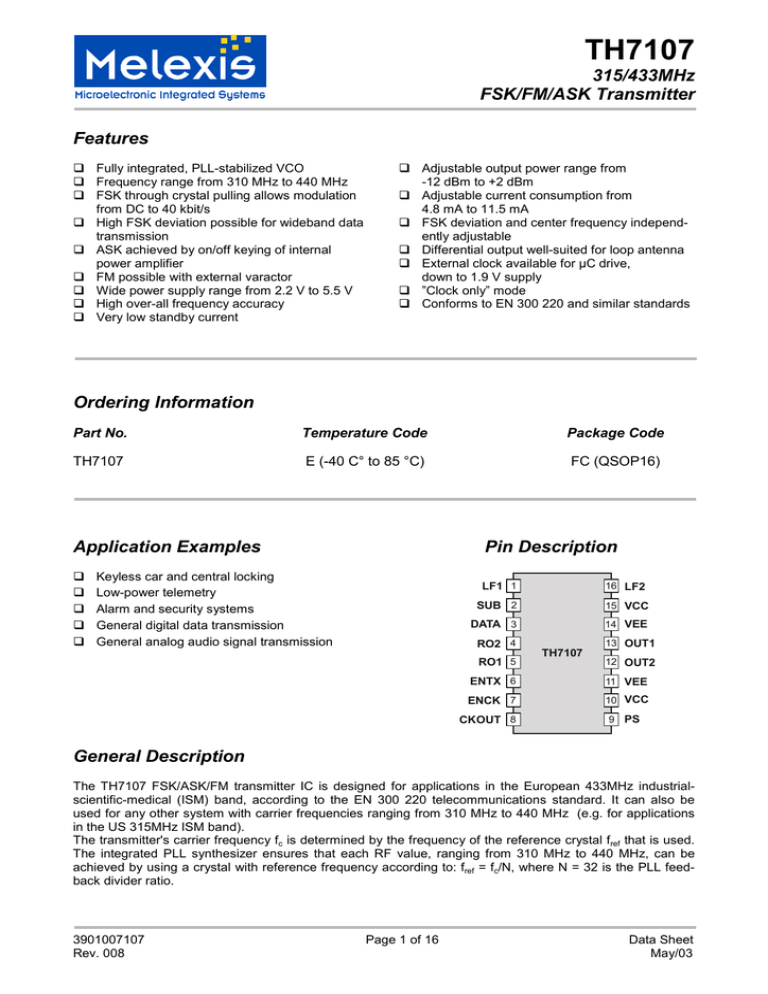
TH7107
315/433MHz
FSK/FM/ASK Transmitter
Features
! Fully integrated, PLL-stabilized VCO
! Frequency range from 310 MHz to 440 MHz
! FSK through crystal pulling allows modulation
from DC to 40 kbit/s
! High FSK deviation possible for wideband data
transmission
! ASK achieved by on/off keying of internal
power amplifier
! FM possible with external varactor
! Wide power supply range from 2.2 V to 5.5 V
! High over-all frequency accuracy
! Very low standby current
! Adjustable output power range from
-12 dBm to +2 dBm
! Adjustable current consumption from
4.8 mA to 11.5 mA
! FSK deviation and center frequency independently adjustable
! Differential output well-suited for loop antenna
! External clock available for µC drive,
down to 1.9 V supply
! ”Clock only” mode
! Conforms to EN 300 220 and similar standards
Ordering Information
Part No.
Temperature Code
Package Code
TH7107
E (-40 C° to 85 °C)
FC (QSOP16)
Application Examples
!
!
!
!
!
Pin Description
Keyless car and central locking
Low-power telemetry
Alarm and security systems
General digital data transmission
General analog audio signal transmission
LF1 1
16 LF2
SUB 2
15 VCC
DATA 3
14 VEE
RO2 4
RO1 5
13 OUT1
TH7107
12 OUT2
ENTX 6
11 VEE
ENCK 7
10 VCC
CKOUT 8
9 PS
General Description
The TH7107 FSK/ASK/FM transmitter IC is designed for applications in the European 433MHz industrialscientific-medical (ISM) band, according to the EN 300 220 telecommunications standard. It can also be
used for any other system with carrier frequencies ranging from 310 MHz to 440 MHz (e.g. for applications
in the US 315MHz ISM band).
The transmitter's carrier frequency fc is determined by the frequency of the reference crystal fref that is used.
The integrated PLL synthesizer ensures that each RF value, ranging from 310 MHz to 440 MHz, can be
achieved by using a crystal with reference frequency according to: fref = fc/N, where N = 32 is the PLL feedback divider ratio.
3901007107
Rev. 008
Page 1 of 16
Data Sheet
May/03
TH7107
315/433MHz
FSK/FM/ASK Transmitter
Document Content
1
Theory of Operation ...................................................................................................3
1.1 General............................................................................................................................... 3
1.2 Block Diagram .................................................................................................................... 3
2
Functional Description ..............................................................................................4
2.1 FSK Modulation .................................................................................................................. 4
2.2 Frequency Modulation ........................................................................................................ 4
2.3 ASK Modulation.................................................................................................................. 4
2.4 Mode Control Logic............................................................................................................. 4
3
Pin Definition and Description ..................................................................................5
4
Electrical Characteristics ..........................................................................................7
4.1 Absolute Maximum Ratings ................................................................................................ 7
4.2 Normal Operating Conditions.............................................................................................. 7
4.3 Crystal Parameters............................................................................................................. 7
4.4 DC Characteristics.............................................................................................................. 8
4.5 AC Characteristics.............................................................................................................. 8
4.6 Output Power Selection ...................................................................................................... 8
5
Crystal Pulling ............................................................................................................9
5.1 Center Frequency as Function of CX1 and CX2 ................................................................. 9
5.2 Frequency Deviation as Function of CX1 and CX2 ........................................................... 10
6
Test Circuit ...............................................................................................................11
6.1 Test circuit component list (Fig. 4) .................................................................................... 11
7
Spectrum Plots.........................................................................................................12
8
Package Information ................................................................................................14
9
Reliability Information..............................................................................................15
10
ESD Precautions ......................................................................................................15
11
Disclaimer .................................................................................................................16
3901007107
Rev. 008
Page 2 of 16
Data Sheet
May/03
TH7107
315/433MHz
FSK/FM/ASK Transmitter
1 Theory of Operation
1.1
General
As depicted in Fig.1, the TH7107 transmitter consists of a fully integrated voltage-controlled oscillator (VCO),
a divide-by-32 divider (div32), a phase-frequency detector (PFD) and a charge pump. An external loop filter
at pin LF determines the dynamic behavior of the PLL and suppresses reference spurious signals. The
VCO’s output signal feeds the power amplifier (PA). RF signal power Po can be adjusted in six steps from
Po = –12 dBm to +2 dBm either by changing the value of resistor RPS or by varying the voltage VPS at pin
PS. The open-collector differential output (OUT1, OUT2) can be used to either directly drive a loop antenna
or to be converted to a single-ended impedance by means of a balanced-to-unbalanced (balun) transformer.
For maximum available output power, the differential output should be matched to a load of about 1 kΩ.
Bandgap biasing ensures stable operation of the IC at a power supply range of 2.2 V to 5.5 V.
1.2
Block Diagram
RPS
VCC 10
VCC 15
9
PS
VEE
14
CKOUT
8
div 4
PA
div32
RO1
OUT2
12
PFD
5
XTAL
mode
control
RO2
charge
pump
4
CX1
3
DATA
1
LF1
16 LF2
antenna
or
balun
VCC
VEE
11
VCO
XOSC
CX2
OUT1
13
ENCK
7
ENTX
6
2 SUB
CF1
RF1
CF2
Fig. 1: Block diagram with external components
3901007107
Rev. 008
Page 3 of 16
Data Sheet
May/03
TH7107
315/433MHz
FSK/FM/ASK Transmitter
2 Functional Description
2.1
FSK Modulation
A Colpitts crystal oscillator (XOSC) is used as the reference oscillator of a phase-locked loop (PLL) synthesizer. FSK modulation is achieved by pulling the crystal (XTAL) through the data. So a CMOS-compatible
data stream applied at input DATA digitally modulates the XOSC. Two external pulling capacitors CX1 and
CX2 allow the FSK deviation and center frequency to be adjusted independently. At DATA = LOW CX2 is
connected in parallel to CX1 leading to the low-frequency component of the FSK spectrum (fmin); while at
DATA = HIGH CX2 is deactivated and the XOSC is set to its high frequency, leading to fmax.
An external reference signal can be directly AC-coupled to pin RO1. Then the TH7107 is used without an
XTAL. The reference signal has to contain the FSK (or FM) and sets the carrier frequency.
2.2
Frequency Modulation
For FM operation an external varactor is required. It simply acts as a pulling capacitor connected in series to
the crystal. Then the analog modulation signal, applied through a series resistor, directly modulates the
XOSC.
2.3
ASK Modulation
The TH7107 can be ASK-modulated by applying data directly at pin PS. This turns the PA on and off and
therefore leads to an ASK signal at the output.
2.4
Mode Control Logic
The mode control logic allows four different modes of operation as listed in the following table. The mode
control pins ENCK and ENTX are pulled-down internally. This guarantees that the whole circuit is shut down
if these pins are left floating.
The clock output CKOUT can be used to drive a µC. This output can be activated by the ENCK pin as required for any specific application. Clock frequency is 1/4 of the reference crystal frequency.
ENCK
ENTX
Mode
Description
0
0
all OFF
whole circuit in standby
0
1
TX only
TX active, no clock available
1
0
clock only
TX standby and clock available
1
1
all ON
TX active and clock available
3901007107
Rev. 008
Page 4 of 16
Data Sheet
May/03
TH7107
315/433MHz
FSK/FM/ASK Transmitter
3 Pin Definition and Description
Pin No.
1
Name
LF1
I/O Type
Functional Schematic
output
Description
charge pump output, connection to loop filter
LF1
200Ω
1
2
SUB
ground
negative power supply, substrate connection
3
DATA
input
FSK data input,
CMOS-compatible
DATA
1.8k
3
4
RO2
analog I/O
XOSC FSK pulling pin,
MOS switch
RO2
4
5
RO1
analog I/O
37k
RO1
5
XOSC connection to XTAL,
Colpitts type crystal oscillator
28p
28p
6
ENTX
input
ENTX
1.1k
mode control input, CMOScompatible with internal pulldown
1.1k
mode control input, CMOScompatible with internal pulldown
6
7
ENCK
input
ENCK
7
3901007107
Rev. 008
Page 5 of 16
Data Sheet
May/03
TH7107
315/433MHz
FSK/FM/ASK Transmitter
Pin No.
8
Name
CKOUT
I/O Type
Functional Schematic
Description
output
clock output,
CMOS-compatible
CKOUT
200Ω
8
9
PS
power-select and ASK input,
high-impedance comparator
logic
analog I/O
20µA
PS
200Ω
TX standby: IPS = 0
TX active: IPS = 20µA
9
10
VCC
supply
positive power supply
11
VEE
ground
negative power supply
12
OUT2
output
13
OUT1
output
VCC
differential power amplifier
output, open collector
VCC
OUT2
OUT1
12
13
VEE
differential power amplifier
output, open collector
VEE
VEE
14
VEE
ground
negative power supply
15
VCC
supply
positive power supply
16
LF2
input
VCO tuning input, connection from loop filter
LF2
200Ω
16
5p
3901007107
Rev. 008
Page 6 of 16
Data Sheet
May/03
TH7107
315/433MHz
FSK/FM/ASK Transmitter
4 Electrical Characteristics
4.1
Absolute Maximum Ratings
Parameter
Symbol
Condition
Min
Max
Unit
Supply voltage
VCC
0
7.0
V
Input voltage
VIN
-0.3
VCC+0.3
V
Storage temperature
TSTG
-65
150
°C
Junction temperature
TJ
150
°C
Thermal Resistance
RthJA
112
K/W
Power dissipation
Pdiss
0.12
W
Electrostatic discharge
VESD1
human body model, 1)
-1.0
+1.0
VESD2
human body model, 2)
-0.75
+0.75
Min
Max
Unit
1) all pins except OUT1, OUT2
4.2
kV
2) pins OUT1, OUT2
Normal Operating Conditions
Parameter
Symbol
Condition
Supply voltage
VCC
2.2
5.5
V
Operating temperature
TA
-40
85
°C
Input low voltage CMOS
VIL
ENTX, ENCK, DTA pins
0.3*VCC
V
Input high voltage CMOS
VIH
ENTX, ENCK, DTA pins
XOSC frequency
fref
set by the crystal
9.7
13.75
MHz
VCO frequency
fc
fc = 32 • fref
310
440
MHz
Clock frequency
fclk
fc = fref / 4
2.4
3.4
MHz
±5
±100
kHz
0.7*VCC
V
FSK deviation
∆fFSK
depends on CX1, CX2 and
crystal parameter
Data rate FSK
RFSK
NRZ
40
kbit/s
FM deviation
∆fFM
adjustable with V1 and CX3
±6
kHz
Modulation frequency FM
fmod
5
kHz
Data rate ASK
RASK
40
kbit/s
Min
Max
Unit
9.7
13.75
MHz
10
15
pF
4.3
NRZ
Crystal Parameters
Parameter
Symbol
Condition
Crystal frequency
f0
Load capacitance
CL
Static capacitance
C0
7
pF
Resonance resistance
R1
60
Ω
-10
dB
Spurious response
3901007107
Rev. 008
aspur
fundamental mode, AT
only required for FSK
Page 7 of 16
Data Sheet
May/03
TH7107
315/433MHz
FSK/FM/ASK Transmitter
4.4
DC Characteristics
all parameters under normal operating conditions, unless otherwise stated;
typical values at TA = 23 °C and VCC = 3 V
Parameter
Symbol
Condition
Min
Typ
Max
Unit
0.05
0.1
µA
Standby current
ISBY
ENCK=0, ENTX=0
Clock only current
ICLK
ENCK=1, ENTX=0
0.7
0.9
1.6
mA
Operating current
ICC
ENCK=x, ENTX=1,
RPS=56kΩ
6
8.6
12
mA
Input current
IIN
DATA=x, ENCK=0,
ENTX=0
-1
1
µA
Pull down current
IPD
ENCK=1, ENTX=1
3
8
30
µA
Pull up current
IPS
ENCK=1, ENTX=1
14
20
24
µA
MOS switch On resistance
RON
DATA=0, ENTX=1
10
25
80
Ω
Typ
Max
Unit
4.5
AC Characteristics
all parameters under normal operating conditions, unless otherwise stated;
typical values at TA = 23 °C and VCC = 3 V;
ENCK = 1, ENTX = 1, RPS = 56 kΩ, fc = 433.6 MHz, test circuit shown in Fig. 4
Parameter
Symbol
Output power
Po
Reference spurs
Pref
Clock spurs
Pclk
Harmonic content
Pharm
Condition
Min
-1
dBm
@ fc ± fref
-44
dBm
@ fc ± fclk
-44
dBm
@ 2fc , 3fc , 4fc
-40
dBm
dBm
Spurious output signal
Poff
VPS ≤ 0.1V
-60
Phase noise
PN
@ fc ± 200kHz
-83
VCO gain
Charge pump current
Clock voltage swing
4.6
dBc/Hz
KVCO
200
MHz/V
ICP
±260
µA
2
Vpp
VCKOUT
Start-up time
-79
Cload = 5pF
ton
from ”all OFF” to any
other mode
1.2
1.4
ms
Output Power Selection
typical values at TA = 23 °C and VCC = 3 V:
ENCK = 1, ENTX = 1, fc = 433.6 MHz, test circuit shown in Fig. 4
RPS / kΩ
Ω
≥ 68
56
47
39
27
15
VPS/ V
≥2
1.1
0.9
0.7
0.5
0.3
Icc / mA
11.5
8.6
7.3
6.2
5.3
4.8
Po / dBm
2
-1
-4
-7
-10
-12
Pharm / dBm
≤-40
≤-40
≤-40
≤-45
≤-45
≤-50
3901007107
Rev. 008
Page 8 of 16
Data Sheet
May/03
TH7107
315/433MHz
FSK/FM/ASK Transmitter
5
Crystal Pulling
5.1
Center Frequency as Function of CX1 and CX2
The center frequency fC is defined as (fmax + fmin) /2.
typical values at TA = 23 °C and VCC = 3 V:
XTAL = 13.55 MHz, Cload = 15 pF, shown in Fig. 2
CX2 = 1 nF
CX2 = 100 pF
CX2 = 47 pF
CX1 / pF
fC / MHz
fC / MHz
fC / MHz
22
433.612
433.619
433.625
32
433.604
433.610
433.614
40
433.598
433.604
433.608
49
433.596
433.601
433.604
61
433.593
433.598
433.600
104
433.587
433.630
433.625
fC / MHz
433.620
433.615
Cx2 = 1nF
433.610
CX2 = 100pF
433.605
Cx2 = 47pF
433.600
433.595
433.590
10
20
30
40
50
60
70
Cx1/pF
Fig. 2: Center frequency vs. CX1, at different CX2
3901007107
Rev. 008
Page 9 of 16
Data Sheet
May/03
TH7107
315/433MHz
FSK/FM/ASK Transmitter
5.2
Frequency Deviation as Function of CX1 and CX2
The frequency deviation ∆f is defined as (fmax - fmin) /2.
typical values at TA = 23 °C and VCC = 3 V:
XTAL = 13.55 MHz, Cload = 15 pF, shown in Fig. 3
CX2 = 1 nF
CX2 = 100 pF
CX2 = 47 pF
CX1 / pF
± ∆f / kHz
± ∆f / kHz
± ∆f / kHz
22
34
27
21
32
25
19
14
40
20
14
10
49
17
11.5
8
61
13
9
5.5
104
8
40
35
f / kHz
30
25
Cx2 = 1nF
20
CX2 = 100pF
15
Cx2 = 47pF
10
5
0
10
20
30
40
50
60
70
Cx1/pF
Fig. 3: Frequency deviation vs. CX1, at different CX2
3901007107
Rev. 008
Page 10 of 16
Data Sheet
May/03
TH7107
315/433MHz
FSK/FM/ASK Transmitter
C1
C6
9
10
ENCK
7
PS
XTAL
RF1
R3
CX3
CF2
CKOUT
VEE
ENTX
6
RO1
5
4
RO2
DATA
3
SUB
2
1 LF1
RF2
CX2
RPS
VCC
11
12
13
L2
14
L1
OUT1
LF2
16
Fig. 4: Test circuit for FSK, ASK and FM;
with 50Ω matching network
C5
C2
VEE
C3
8
L3
C4
OUT2
OUT
15
Test Circuit
VCC
6
CX1
CF1
V1
R1
6.1
1 2
1 2 3
VCC
ENCK
GND
1 2
CKOUT
GND
1 2
ENTX
GND
1 2
FSK
GND
1 2
VCC
GND
C7
FM/ASK
GND
R2
Test circuit component list (Fig. 4)
Part
Size
Value
Tolerance
CF1
CF2
CX1_FSK
CX1_ASK
CX2
CX3
C1
C2
C3
C4
C5
C6
C7
L1
L2
L3
RF1
RF2
RPS
R1
R2
R3
V1
XTAL
0603
0603
0603
0603
0603
0603
0603
0805
0805
0603
0603
0603
1206
0603
0603
0805
0805
0805
0805
0805
0805
0805
SOD323
HC49/S
10 nF
12 pF
39 pF
68 pF
1 nF
1 nF
2.7 pF
0.68 pF
3.9 pF
150 pF
330 pF
330 pF
220 nF
22 nH
22 nH
33 nH
2.0 kΩ
4.3 kΩ
56 kΩ
470 kΩ
30 kΩ
0Ω
BB535
13.55 MHz
fundamental wave
±10%
±10%
±5%
±5%
±5%
±10%
±5%
±5%
±5%
±5%
±10%
±10%
±20%
±5%
±5%
±5%
±10%
±10%
±10%
±10%
±10%
±10%
±30ppm calibr.
±30ppm temp.
Description
loop filter capacitor
loop filter capacitor
XOSC capacitor for FSK (∆f = ±20 kHz), note 1
XOSC capacitor for ASK, trimmed to fC, note 1
XOSC capacitor (for FSK only), note 1
XOSC capacitor (for FM only)
impedance matching capacitor
impedance matching capacitor
impedance matching capacitor
impedance matching capacitor
blocking capacitor
blocking capacitor
blocking capacitor
impedance matching inductor
impedance matching inductor
impedance matching inductor
loop filter resistor
loop filter resistor
power-select resistor
optional pull-up resistor
varactor bias resistor, (for FM only)
ASK jumper, (for ASK only)
varactor diode (for FM only)
crystal, Cload = 12 pF to 15 pF, C0, max = 7 pF,
Rm, max = 40 Ω
Note 1: value depends on crystal parameters
3901007107
Rev. 008
Page 11 of 16
Data Sheet
May/03
TH7107
315/433MHz
FSK/FM/ASK Transmitter
7 Spectrum Plots
All plots depict TH7107‘s typical performance at VCC = 3.0 V and TA = 23 °C,
derived with the test circuit shown in Fig. 4.
Fig. 5: RF output signal and spurious emissions, CW mode (DATA = HIGH)
Fig. 6: Single-sideband phase noise at 500 kHz offset, CW mode (DATA = HIGH)
3901007107
Rev. 008
Page 12 of 16
Data Sheet
May/03
TH7107
315/433MHz
FSK/FM/ASK Transmitter
Fig. 7: FSK modulation with RFSK = 6.6 kbit/s NRZ
Fig. 8: ASK modulation with RASK = 4 kbit/s NRZ
Fig. 9: FM with fmod = 2 kHz, FM input signal with 1 Vpp around 1.5 VDC, DATA = HIGH
3901007107
Rev. 008
Page 13 of 16
Data Sheet
May/03
TH7107
315/433MHz
FSK/FM/ASK Transmitter
8 Package Information
D
ZD
e
7°
E
E1
16
1
b
0.254
(0.010)
L
DETAIL-A
7° + 3°
DETAIL-A
C
A1
A
A2
0.36 x 45°
BSC
(0.0014x45°)
.10 (.004)
Fig. 10: QSOP16 (Quarter size Small Outline Package)
all Dimension in mm, coplanarity < 0.1mm
D
E1
E
A
A1
A2
min
4.80
3.81
5.79
1.35
0.10
1.37
max
4.98
3.99
6.20
1.75
0.25
1.50
e
0.635
b
0.20
0.30
ZD
0.230
C
L
α
0.19
0.40
0°
0.25
1.27
8°
0.075
0.016
0°
0.098
0.050
8°
all Dimension in inch, coplanarity < 0.004”
min
0.189
0.150
0.228 0.0532 0.0040 0.054
max
0.196
0.157
0.244 0.0688 0.0098 0.059
3901007107
Rev. 008
0.025
Page 14 of 16
0.008
0.012
0.009
Data Sheet
May/03
TH7107
315/433MHz
FSK/FM/ASK Transmitter
9 Reliability Information
Melexis devices are classified and qualified regarding suitability for infrared, vapor phase and wave soldering
with usual (63/37 SnPb-) solder (melting point at 183degC).
The following test methods are applied:
•
•
•
IPC/JEDEC J-STD-020A (issue April 1999)
Moisture/Reflow Sensitivity Classification For Nonhermetic Solid State Surface Mount Devices
CECC00802 (issue 1994)
Standard Method For The Specification of Surface Mounting Components (SMDs) of Assessed Quality
MIL 883 Method 2003 / JEDEC-STD-22 Test Method B102
Solderability
For all soldering technologies deviating from above mentioned standard conditions (regarding peak
temperature, temperature gradient, temperature profile etc) additional classification and qualification tests
have to be agreed upon with Melexis.
The application of Wave Soldering for SMD’s is allowed only after consulting Melexis regarding assurance of
adhesive strength between device and board.
For more information on manufacturability/solderability see quality page at our website:
http://www.melexis.com/
10 ESD Precautions
Electronic semiconductor products are sensitive to Electro Static Discharge (ESD).
Always observe Electro Static Discharge control procedures whenever handling semiconductor products.
Your Notes
3901007107
Rev. 008
Page 15 of 16
Data Sheet
May/03
TH7107
315/433MHz
FSK/FM/ASK Transmitter
11 Disclaimer
Devices sold by Melexis are covered by the warranty and patent indemnification provisions appearing in its
Term of Sale. Melexis makes no warranty, express, statutory, implied, or by description regarding the
information set forth herein or regarding the freedom of the described devices from patent infringement.
Melexis reserves the right to change specifications and prices at any time and without notice. Therefore, prior
to designing this product into a system, it is necessary to check with Melexis for current information. This
product is intended for use in normal commercial applications. Applications requiring extended temperature
range, unusual environmental requirements, or high reliability applications, such as military, medical lifesupport or life-sustaining equipment are specifically not recommended without additional processing by
Melexis for each application.
The information furnished by Melexis is believed to be correct and accurate. However, Melexis shall not be
liable to recipient or any third party for any damages, including but not limited to personal injury, property
damage, loss of profits, loss of use, interrupt of business or indirect, special incidental or consequential
damages, of any kind, in connection with or arising out of the furnishing, performance or use of the technical
data herein. No obligation or liability to recipient or any third party shall arise or flow out of Melexis’ rendering
of technical or other services.
© 2002 Melexis NV. All rights reserved.
For the latest version of this document. Go to our website at
www.melexis.com
Or for additional information contact Melexis Direct:
Europe and Japan:
All other locations:
Phone: +32 1367 0495
E-mail: sales_europe@melexis.com
Phone: +1 603 223 2362
E-mail: sales_usa@melexis.com
QS9000, VDA6.1 and ISO14001 Certified
3901007107
Rev. 008
Page 16 of 16
Data Sheet
May/03

